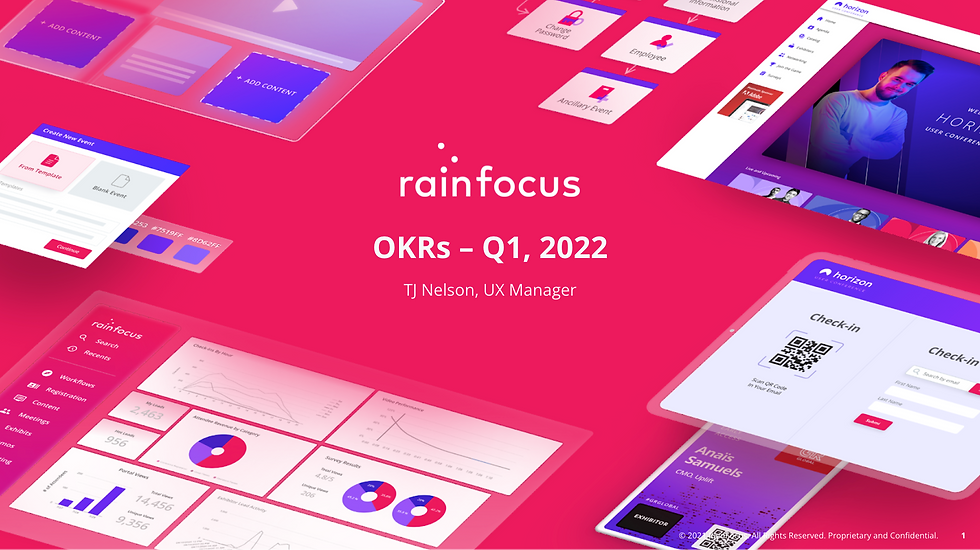Setting Yearly Goals in ADP
- TJ Nelson
- Feb 27
- 4 min read
1. Align Goals With Your Career Level
Use the Career Map (See image below)
Refer to your level and the associated expectations in the career map.
Identify the skills or influence areas relevant to your current level and those one level above you.
Consider Your Next Step
UX Designer (Entry-Level): Focus on foundational UX methods, collaboration basics, and consistent application of core design principles.
UX Designer II (Mid-Level): Expand and refine your UX toolbox, deepen collaboration, and begin to mentor junior designers.
Senior & Staff & Principal (Senior-Level): Emphasize design leadership and influence—both within your immediate team and across departments.

2. Establish 3–5 OKRs Tied to Growth & Influence
Keep It Manageable
Select three to five OKRs to maintain clarity and focus.
Consider both hard skills (tools, methods) and soft skills (leadership, communication, influence).
Link to Career Map
For each OKR, check whether it ties to the next skill or influence milestone in your career map.
3. Understanding Performance Ratings (Meeting vs. Exceeding Expectations)
Meeting Expectations
Definition: Consistently delivering on assigned responsibilities and OKRs at the level expected for your current title.
Outcome: Designers who meet expectations are performing well, contributing value, and should be recognized for maintaining the standard of excellence.
Exceeding Expectations
Definition: Going beyond the scope of your current role in a way that significantly impacts product quality, team functioning, or organizational goals.
Outcome: Designers who exceed expectations regularly may be strong candidates for higher merit increases, additional responsibilities, or advancement opportunities.
Manager’s Perspective
Managers want everyone to meet expectations—this is the baseline of success.
By providing growth opportunities and supportive feedback, managers hope designers can push to exceed expectations.
Exceeding expectations demonstrates readiness for more responsibility or potential career advancement.
4. Craft Meaningful OKRs
The OKR Framework
Objective
A concise statement of what you want to achieve (e.g., "Improve my ability to lead cross-functional design workshops").
Key Results
Measurable outcomes that indicate how you’ll know you’ve succeeded (e.g., "Facilitate at least 3 design workshops with multiple department stakeholders," or "Achieve a 90% satisfaction rating from workshop participants on clarity of outcomes").
Example: Mid-Level Designer
Objective: Strengthen user research skills to make data-driven design decisions.
Key Results:
Conduct and document findings from at least 3 user interviews per quarter.
Present research insights in monthly product team syncs for immediate roadmap impact.
Provide a short training or tip sheet to help junior designers learn best practices in user research.
(Meeting Expectations): Achieves the interviews, documents findings, shares them with the team regularly.(Exceeding Expectations): Proactively teaches others, refines the interview process for broader team use, or links findings to measurable product improvements.
Example: Senior Designer (Influence-Focused)
Objective: Expand design leadership across the department by championing best-in-class practices.
Key Results:
Organize at least 2 cross-team design collaboration workshops each quarter.
Publish a set of scalable design guidelines or best practices, adopted by 2+ product teams.
Mentor a mid-level designer to lead their first full-cycle UX project.
(Meeting Expectations): Coordinates workshops effectively, produces guidelines, and supports one mid-level designer’s growth.(Exceeding Expectations): Gains recognition for significantly improving how teams collaborate, fosters multiple mid-level designers, or drives adoption of guidelines across the entire product org.
5. Leverage the UX Toolbox
Consider skills and tools from the design thinking stages as areas for improvement.
Empathy Tools
User Interviews, Observations, Contextual Inquiries, “Go and See”
Define & Ideation
Problem Framing Workshops, Low-Fidelity Sketching, High-Fidelity Wireframing, Collaborative Brainstorming Sessions
Prototyping & Testing
Rapid Prototypes (paper, digital), Usability Testing, A/B Testing
Facilitation & Collaboration
Workshop Planning, Cross-Functional Sessions, Stakeholder Presentations, Remote Collaboration Tools
Consider creating OKRs around mastering or improving your application of these tools to drive project success and personal growth.
6. Focus on Growth & Influence at Each Level
Early-Stage Designers: Prioritize learning new skills and applying them consistently. Seek feedback from peers and mentors.
Mid-Level Designers: Broaden and deepen existing skills, start leading smaller initiatives, and mentor junior team members.
Senior & Staff Designers: Use advanced expertise to influence design direction and decision-making across teams or departments.
7. Set Realistic Timelines & Checkpoints
Quarterly or Bi-Annual Reviews: Check progress on OKRs every quarter (or mid-year and year-end).
Adjust as Needed: Business priorities shift, so your OKRs may need to evolve. Be sure to have a conversation with your manager if you think updates are necessary.
Celebrate Progress: Both managers and designers should note successes—especially if a designer is on track to exceed expectations.
8. Collaborate & Seek Feedback
Manager Alignment: Ensure your objectives reflect both your aspirations and the team’s or organization’s strategic goals.
Peer Review: Share OKRs with trusted colleagues for feedback and additional insights.
Cross-Functional Partners: If your OKRs involve working with PMs, developers, or other teams, loop them in early to secure support.
9. Connect Performance to Potential Rewards
Meeting Expectations: Indicates solid performance in line with your role. Managers recognize this as success.
Exceeding Expectations: Demonstrates the capacity for a higher level of responsibility and may lead to greater merit increases or advancement opportunities.
Communication is Key: Throughout the year, discuss progress with your manager so they see the evidence of your impact and can advocate for appropriate rewards.
10. Final Tips
Stay Flexible: Be open to shifting priorities, but ensure your OKRs remain relevant.
Aim for Impact: Show how your growth benefits the product, team, and organization.
Document & Reflect: Keep track of your successes and challenges, which helps managers accurately gauge your performance.
Celebrate Wins: Recognize your accomplishments, whether meeting or exceeding expectations.

Photo by S O C I A L . C U T on Unsplash

Comments